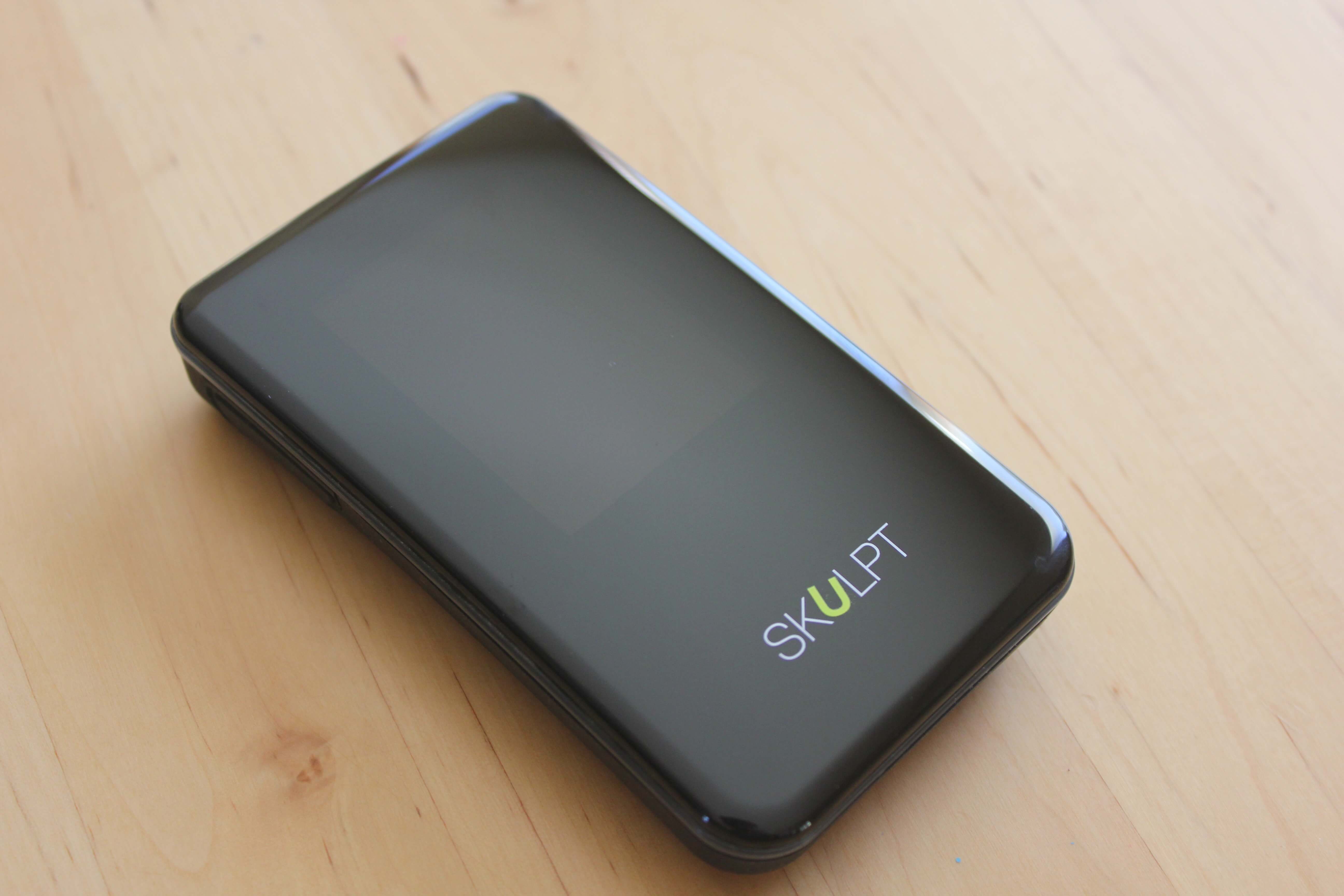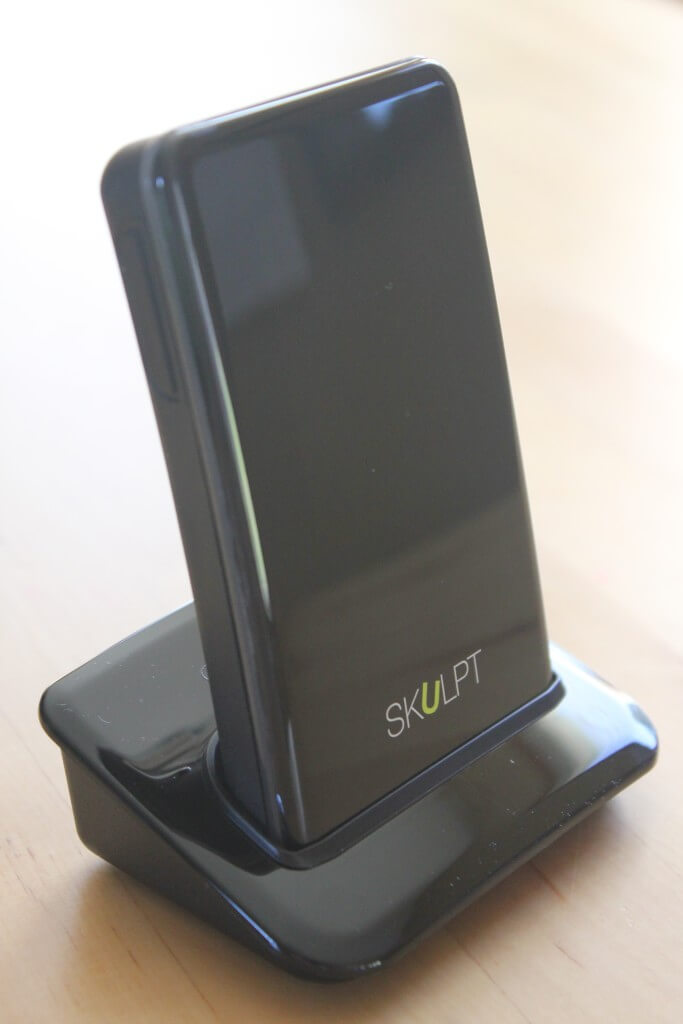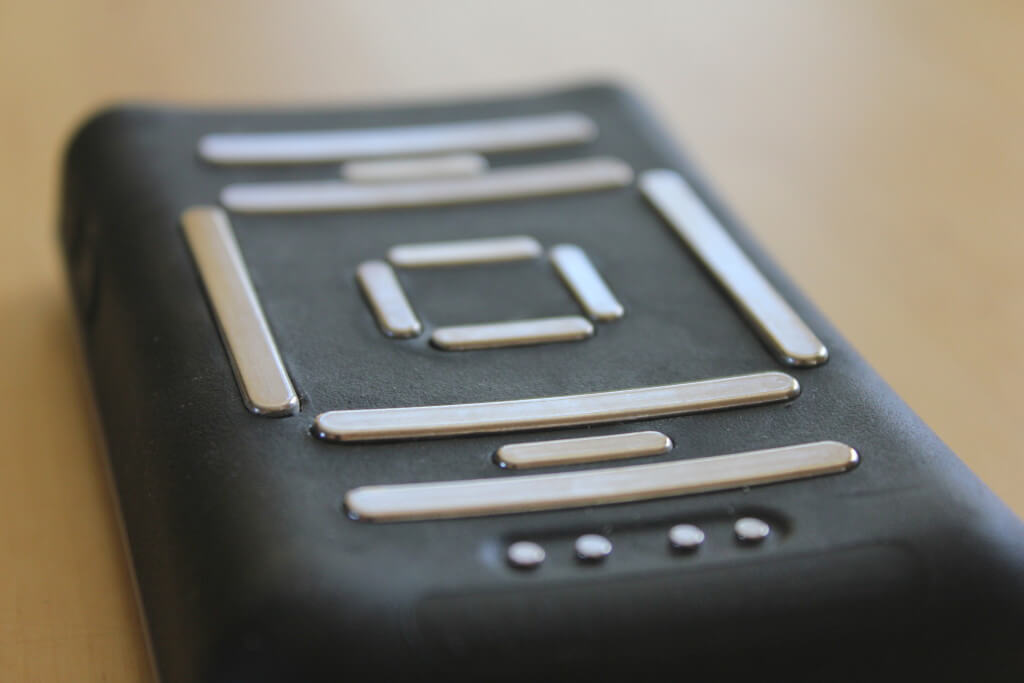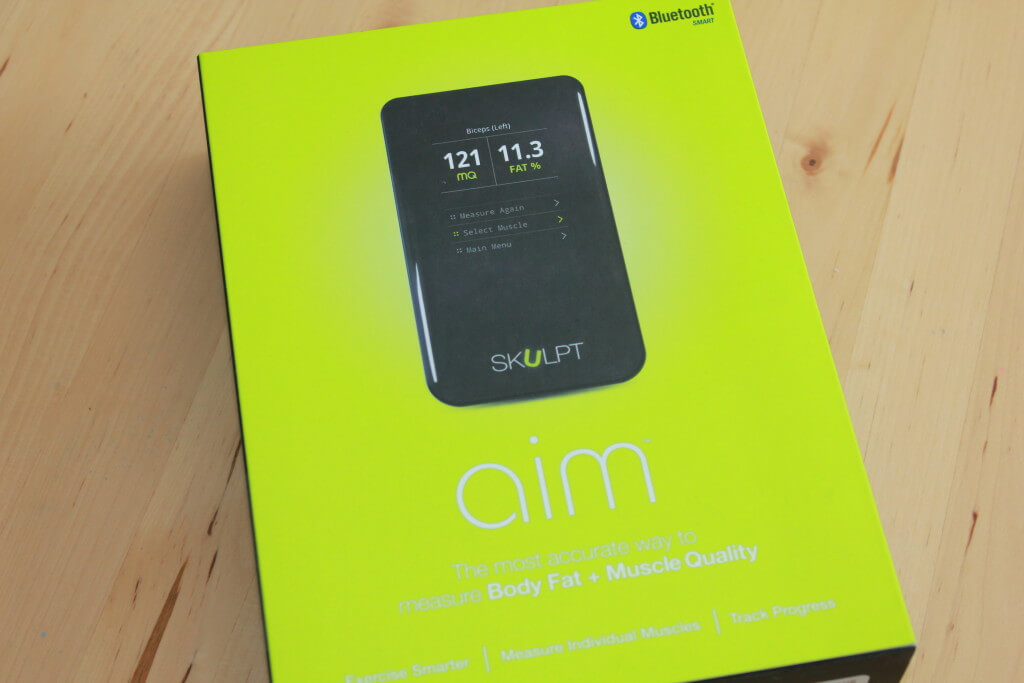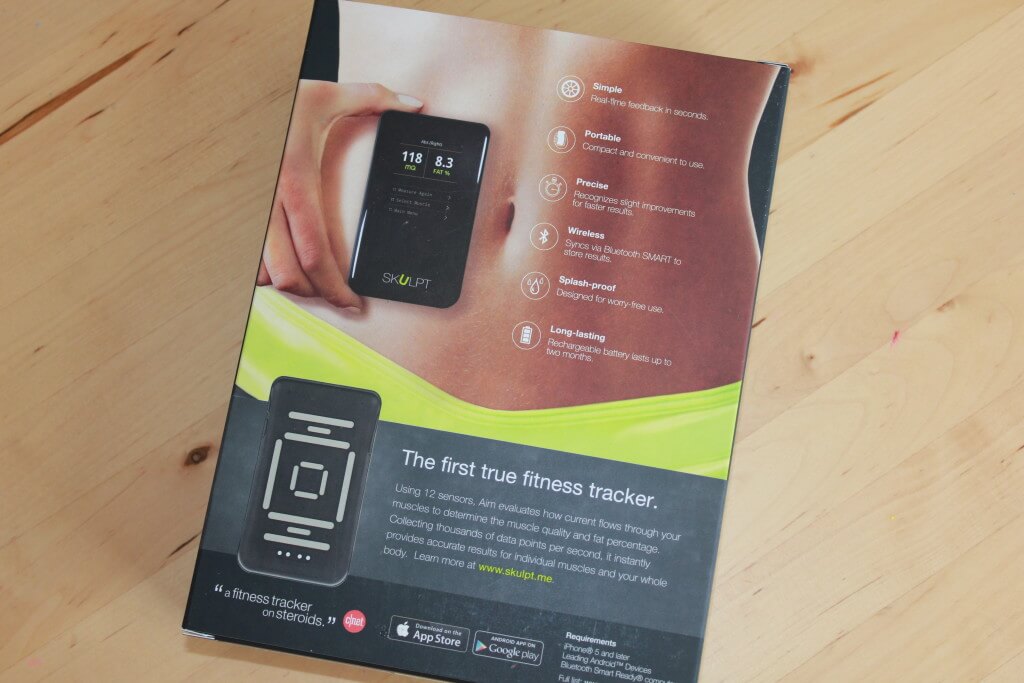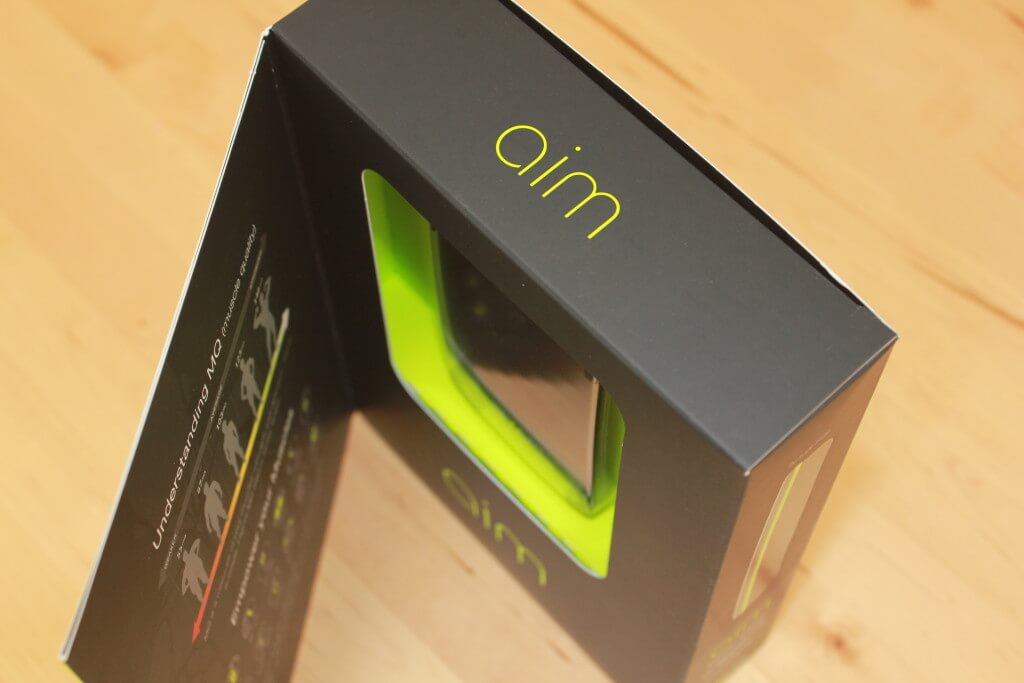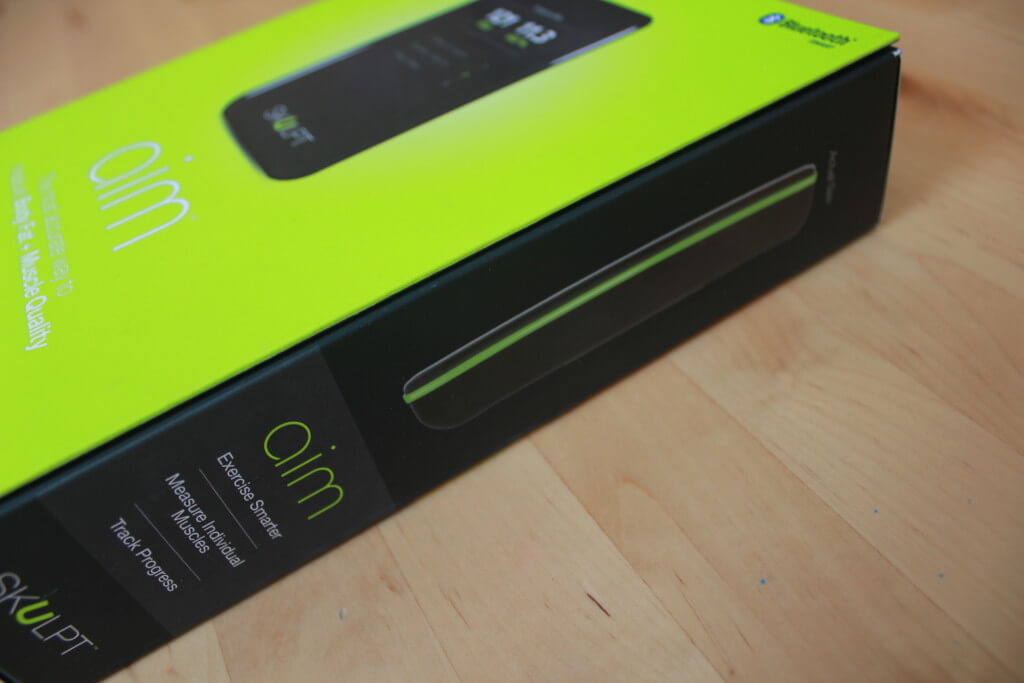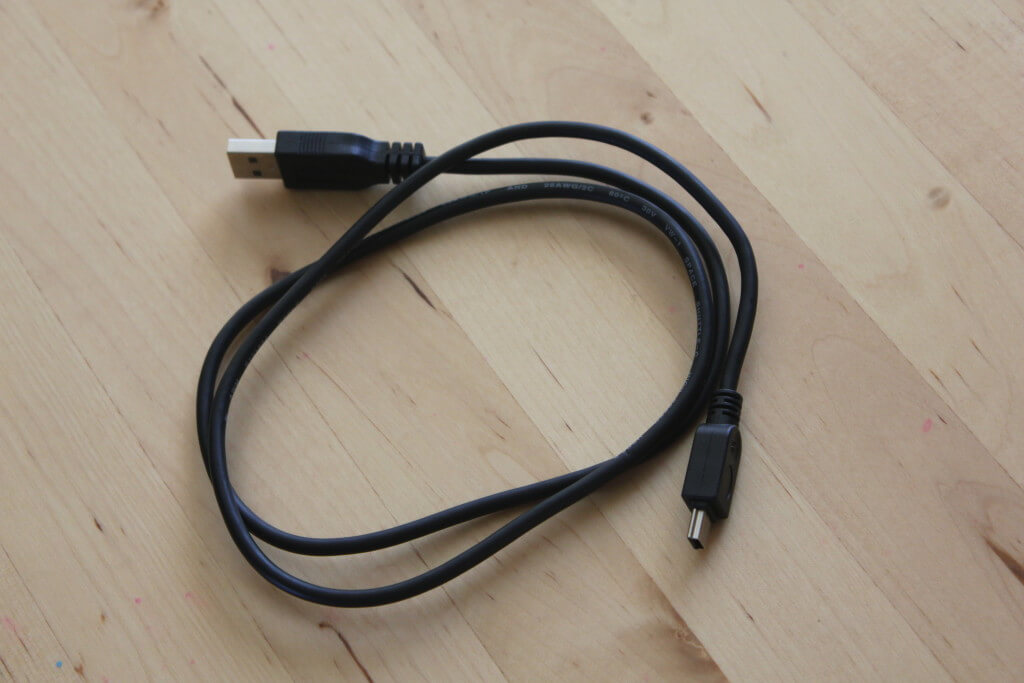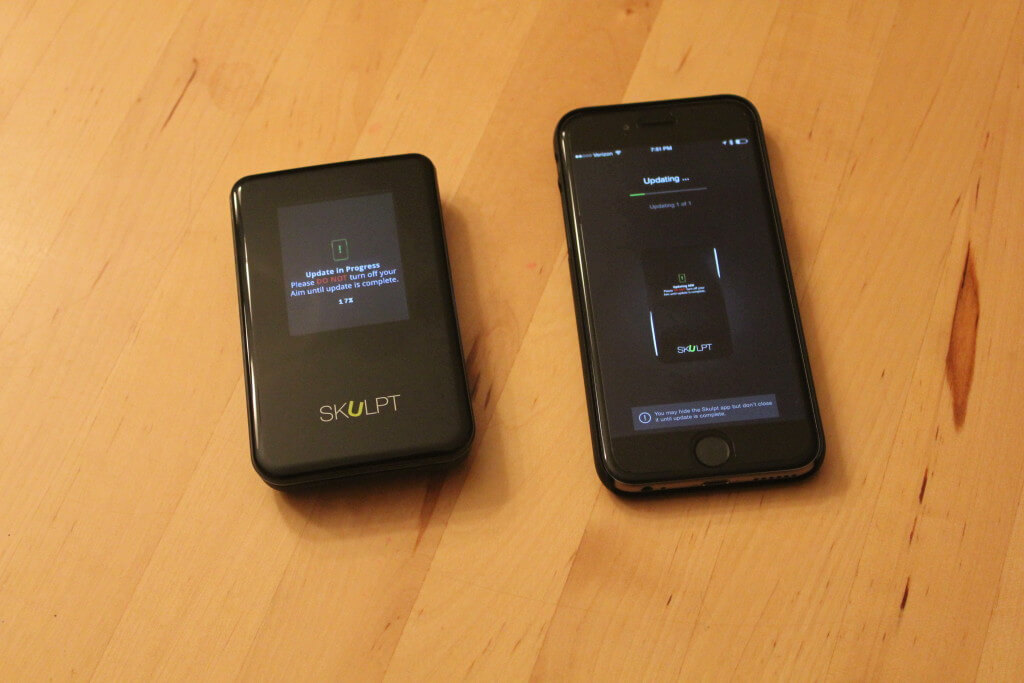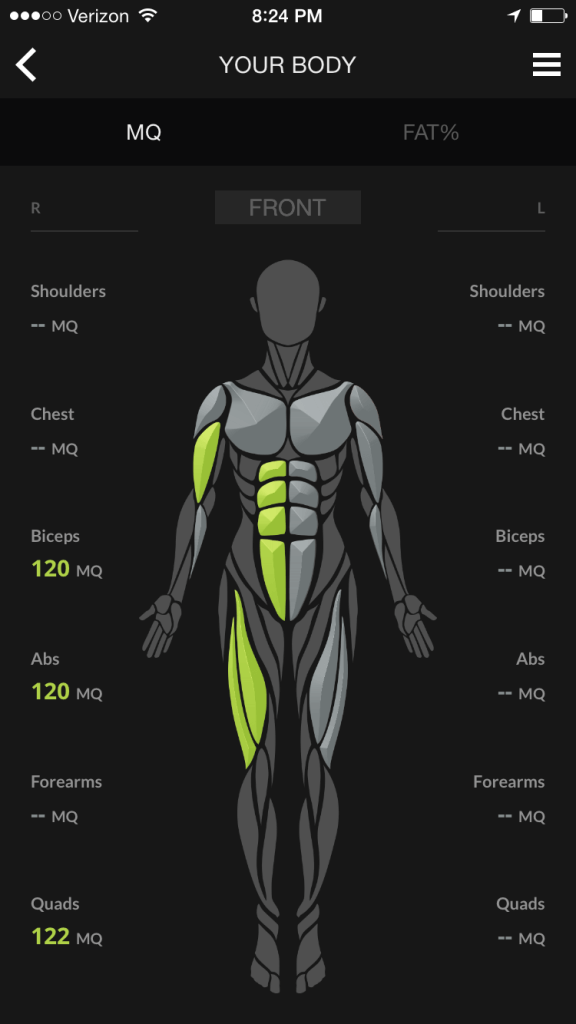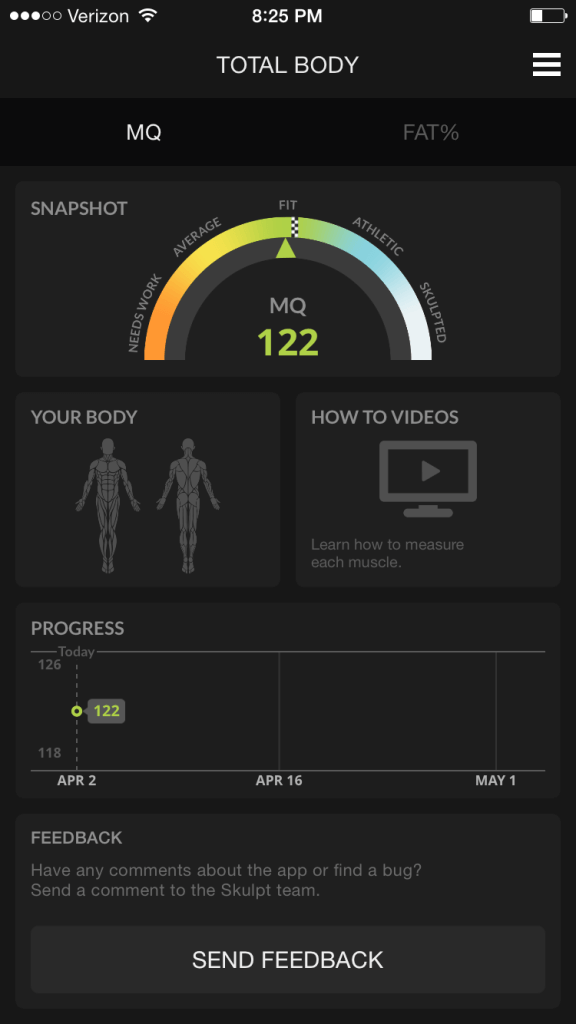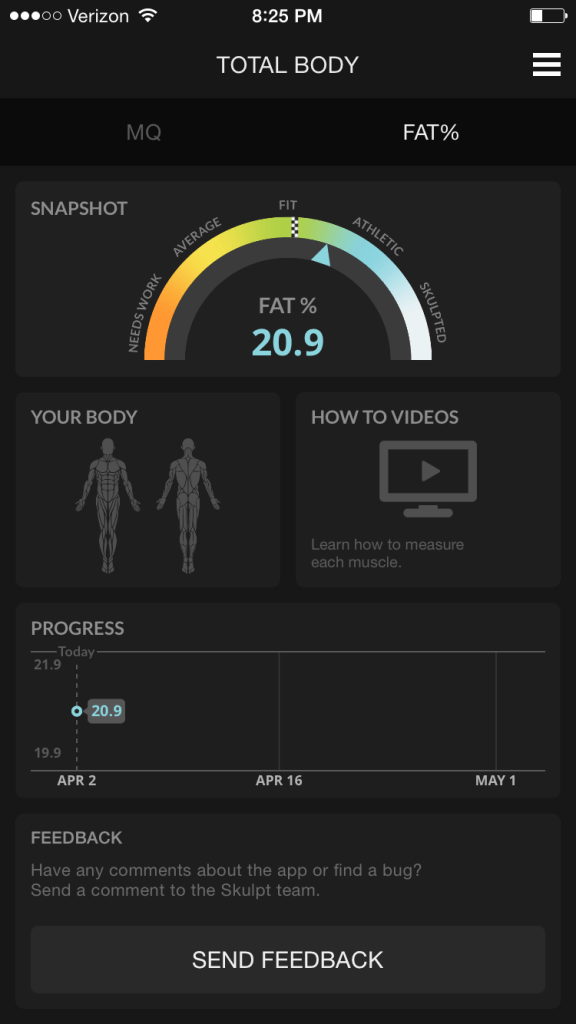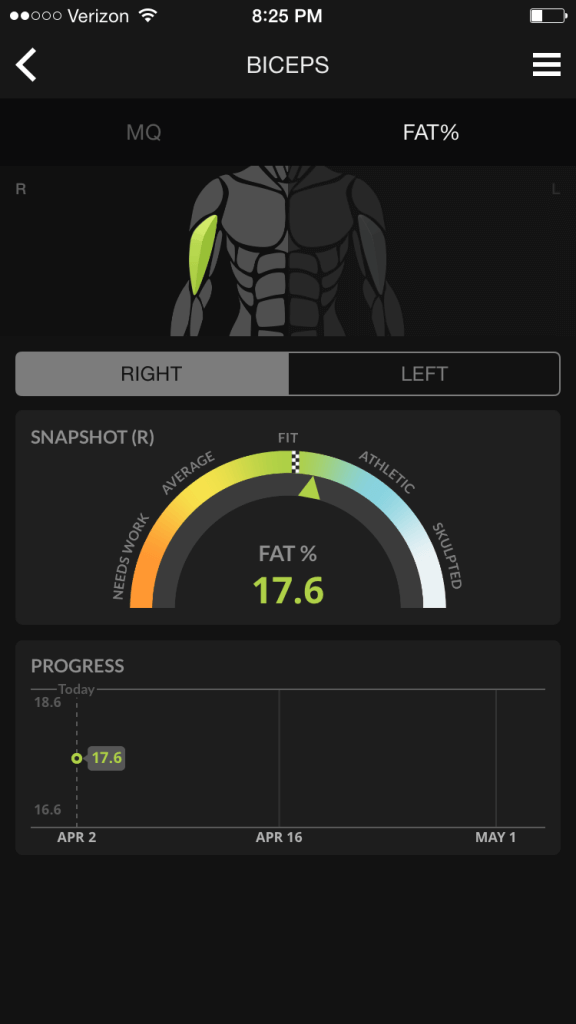Have you ever wondered what your body fat percentage is?
How about the “quality” of your muscle?
The Skulpt AIM is the first device to measure both.
Measure your body fat and muscle quality in minutes – without the pain of needles poked into you muscles or the embarrassment of being pinched with calipers.
It’s safe, utilizing a weak electrical current that you cannot feel and is as easy as using your iPhone.
Are you tenderloin or chuck roast?
I wanted to know for myself, so I ordered one to test and review here.
I’ve had the Skulpt for about a month now and although it’s not perfect . . . it’s a game-changer. There is no other device like it.
The Skulpt AIM is a new technology that gives you unique information about your health.
Let’s get into it . . .
The Skulpt AIM Review
It’s been awhile since I have anticipated something in the mail as much as the Skulpt AIM.
Fortunately it came quick . . from online store to my door in 3 days.
Then I despised the damn thing.
My personal results were sobering.
It revealed the truth – I was not where I wanted to be. My Muscle Quality was 98. I’m average. No one wants to be average (I suppose except those who “need work”).
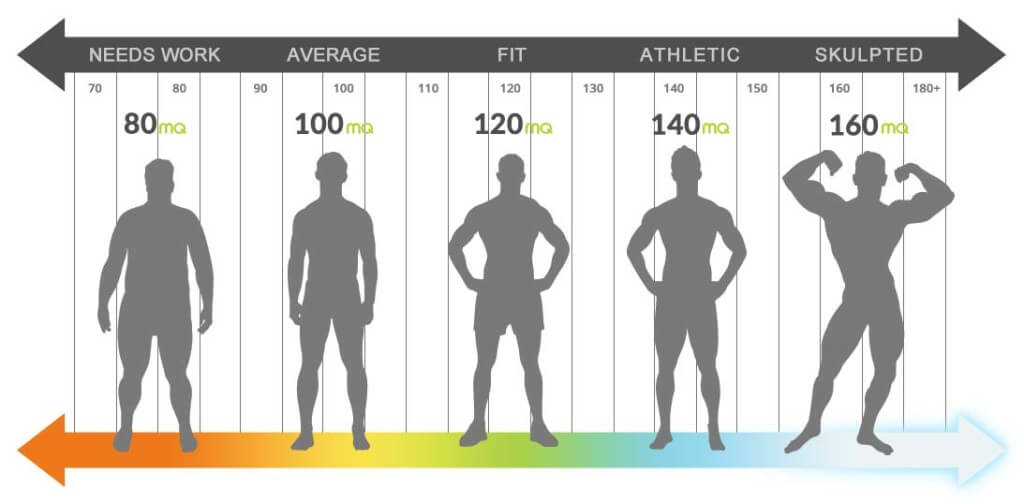
Heartbroken.
I’ve spent too many late work days in clinic and not enough time in the basement pumping iron and doing HIIT.
Than it occurred to me . . . this is empowering.
The information from the Skulpt could change a life.
You can now measure muscle quality and fat % and follow the numbers. If the numbers improve, your on track. If they worsen, you change.
Over several weeks you can track the changes in your habits and know if what you’re doing is effective.
No longer do you need to wonder if your weight change on the bathroom scale is from gaining fat or muscle (or both).
Just measure it with the Skulpt.
The Skulpt AIM is based on a technology called Electrical Impedance Myography (EIM).
The Skulpt AIM was developed by Seward Rutkove, a neurologist at Harvard Medical School along with Jose Bohorquez an electrical engineer and graduate of MIT.
EIM was created as a non-invasive way to study and track muscle disorders such as muscular dystrophy, ALS, and Spinal Muscular Atrophy. The only way to study these diseases prior was to do an EMG, which requires a painful needle to be poked into the muscle.
There’s strange irony and beauty in the fact that a technology studied for muscle disorders will help us build muscle.
Research has been ongoing for over a decade and supported by grants from National Science Foundation and the National Institutes of Health. EIM was even used for NASAA research to study the effects of weightlessness on “astronauts” in space (by studying mice).
This is the ultimate intersection of public research for the greater good and commercial enterprise. Buy a Skulpt and support a scientist (and their research).
I suspect a future line of research using EIM for athletes, muscle conditioning and training. It could also track sarcopenia (muscle wasting) that occurs in all of us as we age (and afflicts the elderly).
The Skulpt AIM is a cross between and iPhone and an old Blackberry (with EIM technology built in of course).
The device looks intuitively like it should have a touch screen, like an iPhone, but it’s more like an original iPod. The menu navigation is slow and difficult.
There’s a On/Off/Select button on the left side and on the right, a button for Menu Up and Menu Down.
The buttons are clunky to operate. They are cased with rubber and stiff to use.
I had to push hard a couple of times to get it right.
I presume this is to keep it water-tight.
Water is needed for conductance against the skin. You spray the back of the device with water where the electrodes. Hence the need to be water-proof.
Opening the box was like getting my first iPad (when iPads were new to the world and innovative)
The packaging was high-end, like you’d expect.
Here’s a series of pics right before I tore up the packaging:
What comes in the box with the Skulpt AIM?
The package contains just a couple of items: the Skulpt AIM itself along with a dock, a small spray bottle, a USB charger and a carry bag.
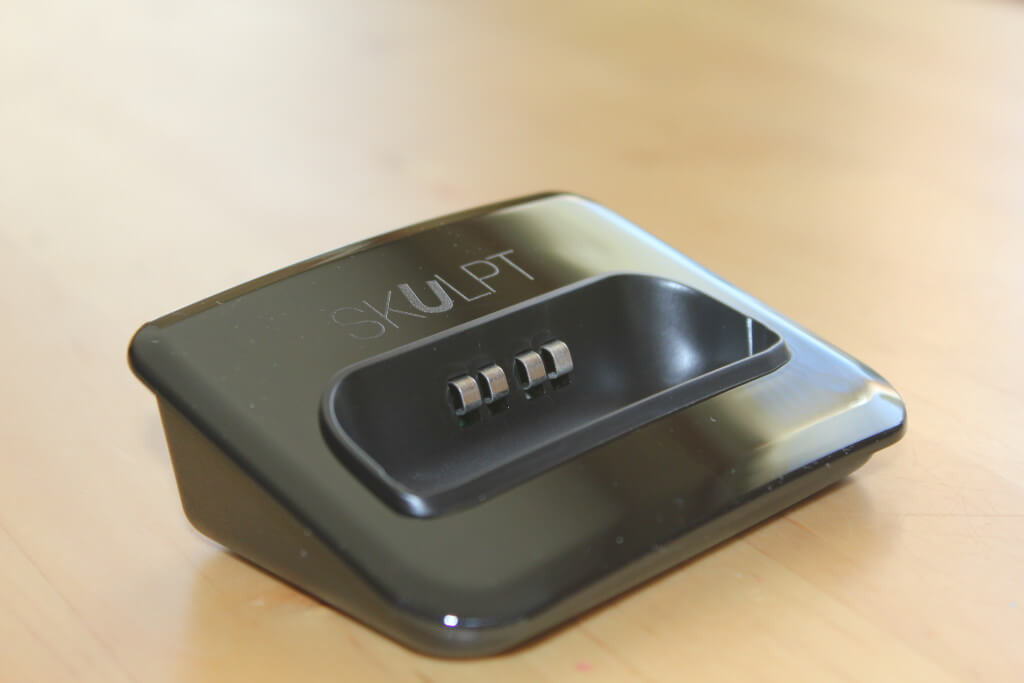
The spray bottle is a pocket-sized spritzer.
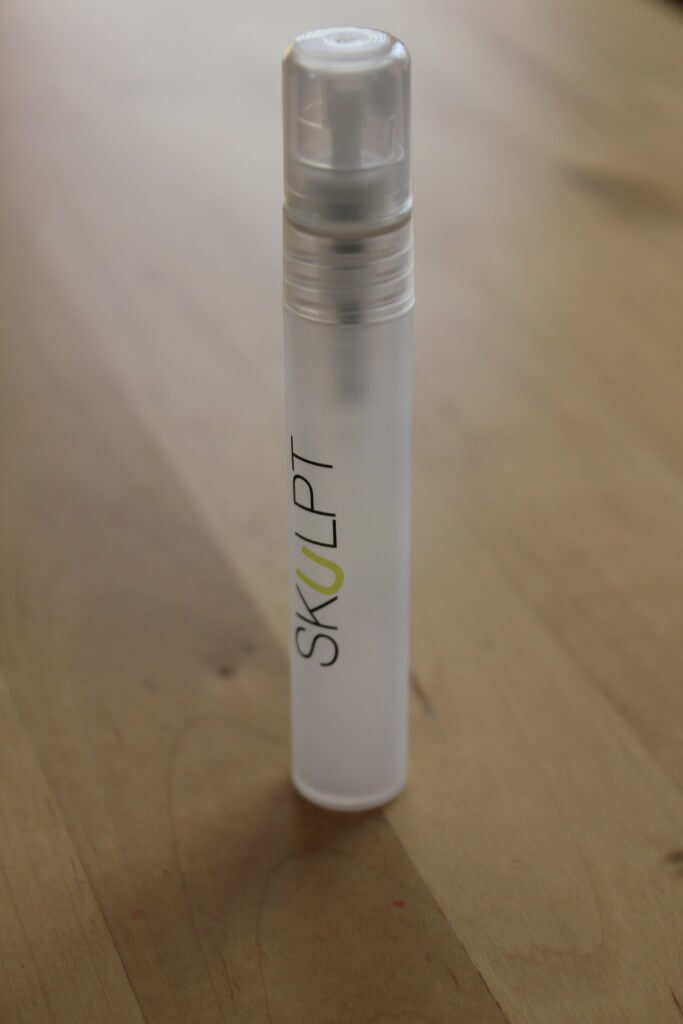
You just fill it with water and you’ve got a handy spray bottle with a fine spray for the sensors.
This was appreciated. It kept me from dousing everything nearby. You’ll get your body slightly wet, but it’s not all too bad.
The water helps connect your skin to the electrodes to help it conduct the low current electricity.
Don’t worry. The current is weak, so you won’t feel a thing. Honestly. Not even a buzz.
It also comes with a handy bag – to keep all your Skulpt stuff together and carry it to the gym.
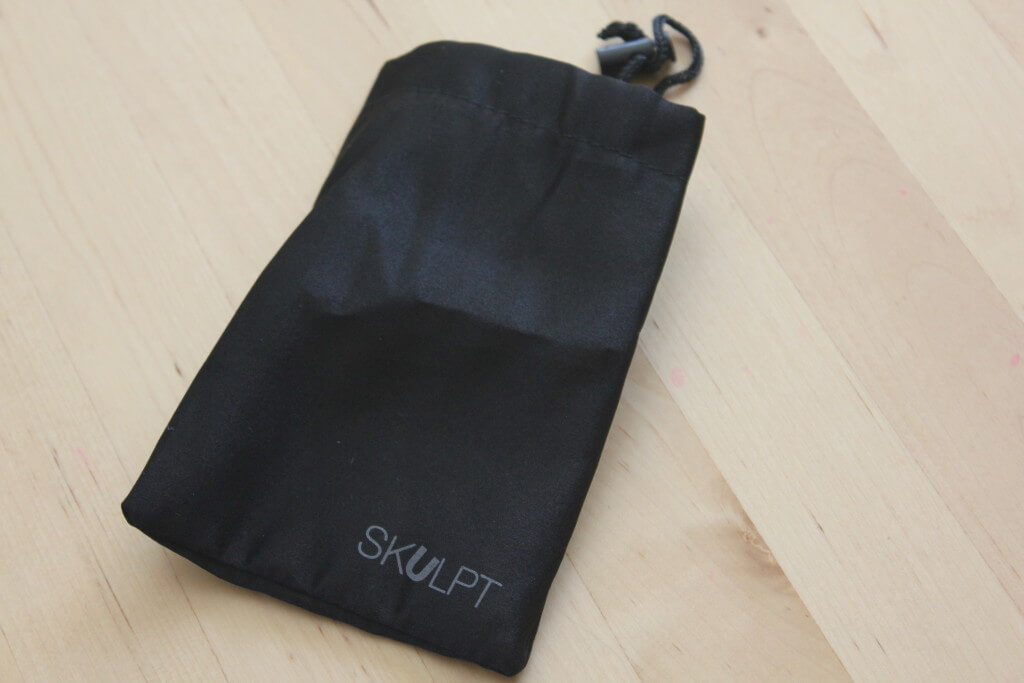
A USB cord is included for charging.
Charging is simple. Just connect it to your computer. No special software is necessary for this and it charges automatically without disturbing your computer.
You could use a USB adapted smartphone wall charger as well.
Set up and syncing the Skulpt
You start the set-up process by charging the Sculpt for about 2 hours. Plug it into the USB port on your computer and let it be. Patiently wait just a couple more hours to get your body fat percentage and muscle quality.
Once it’s charged, download the android or iPhone application. Turn on the device by hitting the power button and follow the directions.
The Skulpt is bluetooth enabled, so it syncs nicely with your phone.
The syncing process was seamless and only took a minute or so.
The set-up also included inputting your biometric data, such as your sex, height and weight.
This is needed for the software to calculate you body fat percentage and muscle quality. So, make sure you are as accurate as possible in regard to you numbers.
You may want to weigh yourself and re-measure your height. I could not find a way to re-do the measurement once it was set up. You may be stuck re-registering as a new user to re-do your data.
The Skulpt AIM app
I’m am impressed with the app.
It neatly organizes your bodyfat measurements and muscle quality on an anatomic muscle chart for you to view. It also tracks the measurements in a graph over time, which comes in handy to track improvements.
You can track multiple muscle groups – 24 distinct muscles in fact. I can see this being extremely useful if you were a bodybuilder or major fitness enthusiast.
The muscle quality snapshot tells you when you are “fit,” “skulpted,” or “need more work.”
There’s also a snapshot view of your body fat percentage for total body.
If total body fat percentage isn’t enough, you can drill down to each muscle group and see individual areas of body fat in addition to your MQ score.
This is why the Skulpt could be ideal for bodybuilders and serious fitness enthusiasts who are competing for a sculpted body to track if they are making very specific improvements.
Who is the Skulpt AIM for?
Anyone who is serious about their health.
This device gives the most accurate measurement of bodyfat percentage available. You can do it in under a minute and it doesn’t require calipers and pinching your flub. What else do you need? Oh yeah, it gives you a reading of muscle quality as well.
Here’s a quick commercial from Skulpt that gives you an idea about how it could be used for your training:
Who is the Skulpt AIM Not for?
Lazy people.
This is a $200 device. If you are too lazy to use it, then don’t bother. It won’t help if you cannot motivate yourself to get the work done.
There is no magic to this device. It doesn’t melt fat away by zapping you with electricity. You still need to do the work, so if this is not possible, then skip the device.
How do you use the Skulpt AIM?
It’s pretty easy.
After you go through the instructions to sync with your phone, it prompts you to spray the sensors and apply the device to four areas on your body to get your initial body fat percentage. This is the biceps, triceps, abdomen and thigh muscles.
You should avoid taking measurements when you’ve been working out. The micro-tears in your muscle can change the accuracy of the measurements. Ideally you take measurements on rest days at the same time preferably in the morning.
When you apply the device to your muscle it “senses” this and a light around the permitter of the device turns from red to blue indicating that it measured the muscle.
The device displays your muscle quality and body fat percentage on the screen.
You can track 24 individual muscles, 12 muscles on each side of the body.
If you want to simply track your overall fat percentage, it does this by tracking your biceps, triceps, abdomen and thigh muscle and averaging these 4 muscles coming up with a more accurate total body reading.
Your numbers are synced to your phone for review. This was intuitive and easy to use. I then added my wife as a second user and she easily synced and did the measurements (and crushed my readings).
The Skulpt can store the profile data for of up to six people.
Here’s another video from Skulpt on how fast and easy it is to use with different people:
How accurate is the Skulpt AIM?
Does the Skulpt AIM really spit out accurate information or is it just a “magic 8 ball?”
Skulpt.me claims that the Skulpt is more accurate then anything else available:
5X more accurate than BIA smart scales
4X more accurate than skinfold calipers
Within 1-2% of gold standard, underwater weighing
I have yet to verify if these claims are true. I would suspect that EIM is more accurate, but I need more time to look at the science.
I’ll need to get back to you on that.
Skulpt.me also claims to have good retest reliability:
Studies have shown that EIM is capable of remarkably good consistency: test-reproducibility variation across different days is within 5%, which is extremely low from the standpoint of any medical test.
This means that when you test and re-test yourself, you can expect about a 5% variation.
How often should you use the Skulpt AIM?
You should complete your initial assessment of you muscle quotient and body fat percentage at least a couple of times. By taking your measurements at least 2-3 times with similar readings you can be confident that you are doing it right and that the machine is working for you. After that I would recommend using the device either weekly or as I plan – once a month.
This gives you ample time to work on your body and make change. You will not see substantial day-to-day changes in muscle mass or fat percentage beyond the measurement error.
Change in terms of measurable muscle gains and fat loss occur slowly over weeks to months. If you work hard you might notice improvements in a couple of weeks.
Weekly measurements would be the shortest interval I would recommend. I could see how weekly measurements could help you to stay motivated. It could be a part of a beginning of the week routine.
Wake up Sunday morning, shower up, grab the Skulpt and see how you compare to last week. I wouldn’t frankly expect much change, but just keeping track is terribly important. Weighing yourself routinely on a weekly basis has been found to help you manage your weight. So, why not use the Skulpt to check in in addition?
Any measurement change between a couple of days is likely to be from other factors such as hydration status and measurement error.
There is an argument for more frequent measurements, however. The more measurements you take the more you get used to the device and understand the “noise” of measurement error. Over time you also get an average trajectory of you improvements (or your failures). You could also take several readings consecutively. For instance, take 3 readings in a row once a week. You’ll likely get 3 separate, but very close readings.
My personal plan is to check myself at the top of every month. This is like my monthly weigh-in to keep me accountable.
How much does the Skulpt AIM cost?
$99 US dollars. Free shipping. You can get it here.
How does the Skulpt AIM work?
It can be difficult to conceptualize how some things work. For instance, my iPhone just magically gets a signal with phone reception and internet access with LTE. I’m not an electrical engineer, so it can be difficult for me to comprehend how this device gets the information.
I have a patient who is an electrical engineer and he once described to me the cells of the body as resistors and capacitors.
Each of our cells have properties that will resist current or propagate it. Tissues can act to resist the electrical current or store the charge and disperse it later. Muscles for instance, can store and then give out a burst of energy. They act as capacitors.
EIM is a weak current that is placed directly over the muscle and tissue. It provides a weak, alternating electrical current that passes through the skin, fat, connective tissue and muscle. The Skulpt reads the resistance and capacitance “profile” of the tissue and determines the muscle quotient and fat percentage from this information.
What’s the battery life of the Skulpt AIM?
The user manual states that with usual use you can expect to get 2 weeks out of it between charges. Inside the Skulpt is a rechargeable NiMH battery.
I used it once initially testing several times in a day and then a week later. As my wife and I were using it, it lost charge. We used it maybe a total of 4-5 times for total body fat percentage, which is about 20 readings.
So, I’m not terribly confident in the battery life. I’m not surprised though. It literally needs to send energy through your body.
I’m ok letting it dock in the charger so it’s available when I need it.
Unfortunately, there is no way to change out the battery. Unless the company decides to offer this as a service, which I doubt.
If the battery dies, the device is done.
What is body fat percentage and why is it important to know?
Our bodies are made up of muscle, fat, bone, and other tissues.
Your overall weight is less important than what that weight is made of (your body composition).
For instance, two bodies can be of the same weight and height. One body can have more fat mass, while the other has more muscle mass.
The body with the higher fat mass is not as healthy.
To separate out the fat, several methods have been developed: skinfold analysis (calipers), bioelectrical impedance, the BOD POD along with others.
For research purposes, DEXA scanning is used most often, which uses two x-rays at different energy levels to determine your bone density, but can, with a bit of additional software, determine a measure of body fat percentage.
Being leaner (having a lower body fat percentage) is generally associated with improved health. However, being too lean is not associated with additional health benefits.
An article from the American College of Sports Medicine by Tiffany Esmat, Ph.D. describes the range of body fat composition for health:
Essential fat is the minimal amount of fat necessary for normal physiological function. For males and females, essential fat values are typically considered to be 3% and 12%, respectively. Fat above the minimal amount is referred to as nonessential fat. It is generally accepted that a range of 10-22 percent for men and 20-32 percent for women is considered satisfactory for good health.
She also describes why having too low of a body fat percentage can be detrimental:
When we drop below the minimal recommended levels of essential fat, we negatively affect the delivery of vitamins to the organs, the ability of the reproductive system to function, and overall well-being.
What is the Muscle Quality (MQ)?
How much of your muscle is muscle?
If you have excess weight, your muscle become infiltrated with fat. Also, as you age fibrosis of the muscle occurs.
So, a muscle is made up of more than just muscle fibers. There’s muscle, but also connective tissue, blood vessels, fat and fibrosis (think scar tissue) as we age.
Seward Rutkove, Harvard researcher, co-founder of Skulpt AIM and the main scientist behind EIM stated this clearly on SI:
[MQ] defines how much of the muscle is muscle as compared to fat, connective tissue, [and] blood vessels
Muscle quality based on the research is the strength of a muscle per unit of muscle mass(or muscle volume).
It’s the strength over size.
MQ = Strength/Size
Therefore the highest MQ would be those muscle that are the leanest and also the strongest.
MQ technically requires a measurement of strength, such as squeezing a hand dynamometer (a handgrip device that tests your strength).
The Skulpt AIM claims to provide the MQ without the strength testing. It does this by measuring the structure of the muscle.
The founders of Skulpt came up with a score of your muscle quality. MQ is scored similar to IQ. An average score is set at 100. Over 100 is better quality muscle, while under 100 is poorer quality.
You can see this from this graphic from Skulpt.me:

How do you improve your Muscle Quality (MQ)?
Seward Rutkove wrote on the Skulpt.me blog about MQ:
. . . your MQ represents a ratio of muscle to fat in a given body area. The more muscle you have relative to fat (or the less fat you have relative to muscle), the higher your MQ will be.
This means there are 2 ways to improve muscle quality . . . lose fat or gain muscle.
Either one improves the MQ. Do both simultaneously – you’ll get faster results.
For example, you start training to run marathons. There’s a good chance you’ll lose fat. Maybe lots of it.
This would improve your muscle quality based on the readings from Skulpt AIM. You have essentially created leaner muscles. Lean muscles are less infiltrated with fat. Think tenderloin steak if you like food analogies.
With marathon running, you could also lose some muscle mass. Don’t believe me, look at the winner of the boston marathon every year. This is not just genetic selection, their traning makes them super-efficient running machines, with only enough muscle to run steadily for miles and miles. You would likely lose more fat than muscle, however, and your MQ would still go up.
If you engaged in a weight lifting program, your muscle size and strength would go up. By gaining muscle mass you would also improve your muscle quality.
Skulpt AIM is like science fiction taking us one step closer to the Star Trek medical tricorder
I envision a day when the Skulpt AIM is just another part of my iPhone . . . along with the touch screen, camera, accelerometer . . . there’s electrical impedance myography on my phone. I already use my phone as a “peripheral brain” to look up drug information, check for drug interactions and to even calculate my patient’s risk of heart attacks. I’ll someday use it to obtain labs, vital signs, EKGs and more.
The Qualcomm Tricorder Xprize has a goal to bring healthcare into the palm of your hand. Teams are competing for a prize worth 10 million dollars to make a real-life Star Trek medical tricorder. Just scan the body and know biometrics and disease processes.
I’m not Bones, but I can see myself using the Skulpt AIM in my clinic. Most primary care clinics use body mass index as a metric to diagnose overweight and obesity, which is highly inaccurate. BMI does an overall poor job of finding those patients who are truly obese. I can see having the Skulpt to test patients to aid in diagnosis of obesity and to help those who are motivated to lose weight by tracking them throughout the year.
Skulpt AIM is the stuff of science-fiction happening right before our eyes.
